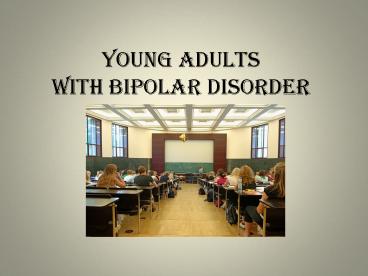Young Adults with Bipolar Disorder - PowerPoint PPT Presentation
Title: Young Adults with Bipolar Disorder
1
Young Adults with Bipolar Disorder
2
Biological Factors
- Strong genetic tie between bipolar and other
mental illnesses in a family - No specific causes, however, certain triggers
such as stress or substance use could initiate an
episode - Prevalence among males and females are equal
- Individual can manage their episodes by learning
the triggers, dealing with the sleep
disturbances, and taking prescribed medications - Stop taking their medication when they feel
better because they think theyre cured - Some symptoms can be controlled through diet
and/or medication, such as vitamin deficiencies
which cause some chemical imbalances (Vitamins
and Minerals may be beneficial
http//depression.about.com/cs/diet/a/vitamin.htm?
p1 to read about the specific benefits)
3
- Often like how they feel and all they accomplish
during a manic episode - Characterized by variations in mood, from elation
and/or irritability to depression causing major
disruptions in family, social, and occupational
life (Grissold Pessar, 2000), - Early-onset bipolar disorder (before age 18)
carries more comorbidity, suicidality, and
substance abuse than later-onset bipolar
disorder.The main issue is not whether the
patient is a child or an adult but at what age
and stage of development he/she begins to display
impairment due to bipolar symptoms. (Chang,
2007). - Three of the borderline characteristics emerged
as potentially useful in differentiating bipolar
depression from unipolar depression Ive never
threatened suicide or injured myself on
purpose... I have tantrums or angry
outbursts and Giving in to some of my urges
gets me into trouble (Smith, Muir,
Blackwood, 2005).
4
- Considered good workers during their manic
episodes, and often dont want to take
medications because it reduces their production - Often seen as school failures, occupational
problems, and poor relationship partners - First episode of a male is typically mania,
females first episode is most often MDD (major
depressive disorder) - Have a greater difficulty with job longevity
often losing a job during a depressive episode - People at risk for mania have also been found to
have high educational and occupational
attainment (Kwapil, Miller, Zinser, Chapman,
Chapman, Eckblad, 2000)
5
- Risk of suicidal attempts and completed suicides
are higher than in many other diagnoses by 10-15 - Often co-morbid with eating disorders, panic
disorder, substance use disorders, and attention
deficit disorder - No indication that bipolar disorder is more
prevalent in a given racial or ethnic group - African-Americans are diagnosed more severe and
usually treated unfairly often receiving no
access to treatment or are incarcerated for their
impulsive activity
6
- The individual with bipolar disorder is looked
down upon by society and often their family.
Often this occurs prior to the individual being
diagnosed and society calls them strange. Once
the diagnosis is known, little changes except
that society now believes their reason for
shunning this individual is justified. - Society assumes the following about individuals
with bipolar you dont want to be married to
them, they dont make good parents, theyre poor
workers, and not very smart. - By changing how providers (medical and other
professionals) view individuals with bipolar we
can change how a person with bipolar views
themselves. - It is important to equip individuals with
knowledge and a good understanding of how their
diagnosis may affect their everyday life. By
changing how they respond, their family,
community, and society may learn that the
stereotypical view of someone with bipolar is not
the norm. By being open-minded, the professional
will be more accepting and understanding about
their clients SCR. - Research on why some medications quit working
after theyve been successful for a period of
time. Behavioral options for managing
uncontrolled, inappropriate behaviors, e.g., the
urge to spend as a way of feeling better and ways
to help this population discover more appropriate
behaviors which would give them equal or near
equal gratification. - Encouraging this population to discover their
strengths, building their support system, and
dont allow them to get away with being brats.
This comes from personal experience.
7
- Professionally, my first client with Bipolar
disorder said she doesnt take her medication
when she is manic because she is able to get a
lot done that during her depressive stage she is
unable to accomplish at all. - Individuals with Bipolar cycle from manic to
depression at differing rates. If the cycle is
slower, they seem to have longer periods of more
normal mood. (Knowledge gained through direct
client contact and education.) - Most often this population have few close friends
and many have mental illnesses. If the spouse of
this population has prior knowledge and
education, they appear to have a better outlook
on what needs to be done. If they discover this
after marriage, they not prepared to deal with
the problems associated and want out of the
marriage.
8
- Chang, K. (M.D.). (2007). Adult bipolar disorder
is continuous with pediatric bipolar disorder.
The Canadian Journal of Psychiatry, 52(7),
418-425, Retrieved September 13, 2008, from
Academic Search (at EBSCOhost) database. - Griswold, K. S., Pessar, L. F. (2000).
Management of bipolar disorder. American Family
Physician, 62(6), 1343. Retrieved September 13,
2008, from ProQuest database. - Kwapil, T. R., Miller, M. B., Zinser, M. C.,
Chapman, L. J., Chapman, J., Eckblad, M.
(2000). A longitudinal study of high scorers on
the Hypomanic Personality Scale. Journal of
Abnormal Psychology, 109, 222-226. - Smith, D. J., Muir, W. J., Blackwood, D. H. R.
(2005). Borderline personality disorder
characteristics in young adults with recurrent
mood disorders A comparison of bipolar and
unipolar depression. Journal of Affective
Disorders, 87(1), 17-23. Retrieved September 13,
2008, from Academic Search (at EBSCOhost)
database.

